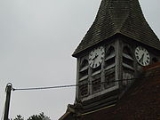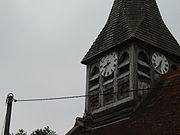
Wootton Rivers
Encyclopedia
Wootton Rivers is a small village located between Pewsey
and Marlborough in Wiltshire
.
 The village and its church are built on what was originally the site of a Saxon manor house. At the start of the 14th century it came into the hands of the de la Riviere family, after whom it is now named. The church is dedicated to St Andrew and has an attractive wooden steeple into which was built an unusual clock made out of scrap iron, brass weights, gun metal and brass pipes. The clock has three faces using the letters GLORY.BE.TO.GOD instead of numerals. Its chiming mechanism is like that of a musical box and plays six distinct tunes. It stands at the south end of the village with the rectory house, and the demesne farmstead, now called Manor Farmhouse.
The village and its church are built on what was originally the site of a Saxon manor house. At the start of the 14th century it came into the hands of the de la Riviere family, after whom it is now named. The church is dedicated to St Andrew and has an attractive wooden steeple into which was built an unusual clock made out of scrap iron, brass weights, gun metal and brass pipes. The clock has three faces using the letters GLORY.BE.TO.GOD instead of numerals. Its chiming mechanism is like that of a musical box and plays six distinct tunes. It stands at the south end of the village with the rectory house, and the demesne farmstead, now called Manor Farmhouse.
The Kennet and Avon Canal was built across one end of the village about 1807 and was opened fully in 1810. The Wootton Rivers Lock had a keeper's house and an associated wharf. The canal was restored in the 1970s and the locks were reopened in 1973. The Mid-Wilts railway, now lifted, was built parallel to and immediately south of the canal in 1862. A passenger halt was opened at the south end of the village in 1928 and closed in 1964. A gazeteer of 1872 mentioned that there was also a post-office, an iron foundry and an agricultural implement factory and that the church ran a national school. It still retains a 16th century pub, which is thatched like much of the rest of the village. In the 19th century there was a population of over 400 people which has since shrunk to half that size. Most of the village was designated a conservation area in 1975 and contains some 25 buildings dating from before 1800.
Pewsey
Pewsey is a large village, often considered a small town, at the centre of the Vale of Pewsey in Wiltshire about west of London. It is well connected to London, the West Country and Wales being close to the M4 motorway and the A303. Also, the village is served by Pewsey railway station on the...
and Marlborough in Wiltshire
Wiltshire
Wiltshire is a ceremonial county in South West England. It is landlocked and borders the counties of Dorset, Somerset, Hampshire, Gloucestershire, Oxfordshire and Berkshire. It contains the unitary authority of Swindon and covers...
.
The village

The Kennet and Avon Canal was built across one end of the village about 1807 and was opened fully in 1810. The Wootton Rivers Lock had a keeper's house and an associated wharf. The canal was restored in the 1970s and the locks were reopened in 1973. The Mid-Wilts railway, now lifted, was built parallel to and immediately south of the canal in 1862. A passenger halt was opened at the south end of the village in 1928 and closed in 1964. A gazeteer of 1872 mentioned that there was also a post-office, an iron foundry and an agricultural implement factory and that the church ran a national school. It still retains a 16th century pub, which is thatched like much of the rest of the village. In the 19th century there was a population of over 400 people which has since shrunk to half that size. Most of the village was designated a conservation area in 1975 and contains some 25 buildings dating from before 1800.

